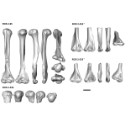Holotype of Hamadasuchus rebouli
3D models related to the publication: Shape diversity in conodont elements, a quantitative study using 3D topography
Inner ear morphology in wild vs laboratory mice
3D GM dataset of bird skeletal variation
Skeletal embryonic development in the catshark
Bony connexions of the petrosal bone of extant hippos
bony labyrinth (11) , inner ear (10) , South America (8) , Eocene (8) , skull (7) , brain (6) , Oligocene (6)
Maëva Judith Orliac (17) , Lionel Hautier (17) , Bastien Mennecart (12) , Laurent Marivaux (11) , Pierre-Olivier Antoine (11) , Leonardo Kerber (10) , Renaud Lebrun (9)
Complete right humerus ROS 2-95 attributed to the Adapis group
Data citation:
Judit Marigó , Nicole Verrière and Marc Godinot
, 2018. M3#356. doi: 10.18563/m3.sf.356
Model solid/transparent
Download 3D model

|
3D models related to the publication: Systematic and locomotor diversification of the Adapis group (Primates, Adapiformes) in the late Eocene of the Quercy (Southwest France), revealed by humeral remains.Judit Marigó, Nicole Verrière and Marc GodinotPublished online: 20/12/2018Keywords: Adapis; humeri; locomotion; Quercy https://doi.org/10.18563/journal.m3.75 Abstract The present 3D Dataset contains the 3D models analyzed in the publication “Systematic and locomotor diversification of the Adapis group (Primates, Adapiformes) in the late Eocene of the Quercy (Southwest France), revealed by humeral remains”. In this paper, twenty humeral specimens from the old and new Quercy collections attributed to the fossil primates Adapis and Palaeolemur are described and analysed together. In this dataset only the scans of the fossils belonging to the collections of Université de Montpellier are provided. M3 article infos Published in Volume 04, issue 03 (2018) |
|